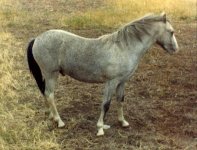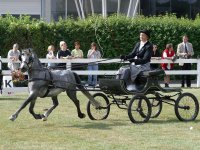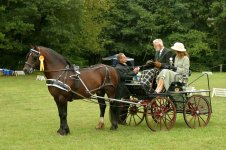♘امیرحسین♞
♘ مدیریت انجمن اسب ایران ♞
The Welsh Pony designates a group of four related types of pony and horse native to the United Kingdom: the Welsh mountain pony (Section A), the Welsh pony (Section B), the Welsh pony of cob type (Section C), and the Welsh Cob (Section D).
Welsh ponies and cobs are suitable mounts for both children and adults. The modern Welsh Pony is known as a riding and driving pony. It is shown both in hand and under saddle, and is a popular children's pony. The breed is used for dressage, eventing, and show jumping. The Welsh also crosses well with many other breeds and has influenced the Pony of the Americas and the Riding Pony. Many are also bred with Thoroughbreds, American Quarter Horses, and Appaloosas. The Welara, a cross between the Welsh pony and the Arabian horse, has its own registry. Welsh ponies may be any colour except pinto.
History
The original Welsh Mountain Pony is thought to have evolved from the prehistoric Celtic pony. Welsh ponies were primarily developed in Wales and existed in the British Isles prior to the arrival of the Roman Empire. They were adapted to the difficult climate of severe winters and sparse vegetation. Shelter most often was an isolated valley or a clump of bare trees. Bands of ponies roamed in a semi-feral state climbing mountains, leaping ravines, running over rough terrain. Therefore the Welsh pony developed intelligence, speed and soundness, and is known for "heart" and endurance. They are tough and thrifty, with a steady, tractable, and calm nature.
When the Romans occupied Ancient Britain, they brought horses of their own, which bred with the native ponies, producing hardy offspring with substance and attractive appearance. It is believed that Julius Caesar founded a stud for the ponies on the shores of Lake Bala. The characteristics of the breed as it is known today are thought to have been established by the late fifteenth century, after Crusaders retured to England with Arabian stallions obtained from the Middle East.
In the 1500s, King Henry VIII, thinking to improve the breeds of horses, particularly war horses, ordered the destruction of all stallions under 15 hands and all mares under 13 hands. Fortunately the ponies in the wild, remote, and inaccessible mountains of Wales escaped this order.
On the upland farms of Wales, Welsh ponies and cobs would often have to do everything from plowing a field to carrying a farmer to market or driving a family to church on Sunday. When coal mining became important to the economy of England, many Welsh ponies were used in mines, for pulling carts. In the eighteenth and nineteenth centuries, more Arabian blood was added by stallions who were turned out in the Welsh hills. Other breeds have also been added, including the Hackney, Thoroughbred, Norfolk Roadster, and the Yorkshire Coach Horse.
In 1901, the Welsh Pony and Cob Society was formed, with the first Stud Book published the following year. It wasn't until 1949 when the sections of the Stud Book (A, B, C, and D) were introduced. One important stallion in the Welsh breed since the 1900s was Dyoll Starlight, credited to have been the foundation sire of the modern breed, who was a combination of Welsh and Arab breeding. From his line came an influential stallion of the Section B type: Tan-y-Bwlch Berwyn. This stallion was sired by a Barb and out of a mare from the Dyoll Starlight line.
Section A
The Welsh mountain pony (Section A) may not exceed 12 hands (122 cm/48 inches ) in height. They have a dished face (from the Arabian influence) with small ears and large eyes. They are sure-footed with sound feet and dense bone, and are very hardy. The ponies should have a sloping shoulder, deep chest, short back, and round rib cage. Their legs should be fine with good hocks.
Section B
The Welsh Pony (Section B), the Welsh Pony of Riding Type, is part of the Welsh Breeds (which also include Welsh mountain pony (Section A), Welsh pony of cob type (Section C), and Welsh Cob (Section D)).
Section B ponies are taller than the closely related Welsh mountain pony (Section A) with a maximum height of 13.2 hh (1.37 m) in the UK and 14.2 hh (1.47 m) in the U.S. They are known for elegant movement and athletic ability while still retaining the substance and hardiness of the foundation stock, the Section A Welsh pony.
Section B ponies also generally have a slightly lighter build, as a result of Thoroughbred and Hackney blood. Section B ponies should resemble the Sec. A pony, but are of a more refined "riding type". However, they should not be light of bone; they should resemble their Mountain Pony ancestors for quality of bone. In addition to the desirable characteristics of the Type A pony, Type B ponies have a free-flowing movement. They should have a muscular neck, arching from withers to poll, and have a deep, wide chest.
Section C
The Welsh pony of Cob Type (Section C) should be no taller than 13.2 hands (137 cm). However, unlike the Welsh pony (Section B), it is heavier and more coblike and compact.
The Welsh Pony of Cob Type first resulted from a crossbreeding between the Welsh mountain pony (Section A) and the Welsh Cob (Section D). There were also crosses with Spanish horses, which led to the development of the Powys horse, which was also a foundation for this type. Other breeds also influenced the type, including the Norfolk Roadster, the Hackney and Yorkshire Coach Horse.
The ponies have a straight profile with large, expressive eyes.They have clean limbs with silky feathering, and have sound feet. Their movement is extravagant and high-stepping.
The Welsh Pony of Cob Type is considered more spirited and independent than the Welsh mountain pony (Section A) or Welsh pony (Section B). They are easy keepers, with stamina and endurance. Today, the type is used mainly in harness for competitive driving.
Influential stallions on the Section C and D bloodlines include:
* Trotting Comet: foaled in 1840 from a long line of trotting horses
* True Briton: foaled in 1930, by a trotting sire and out of an Arabian mare
* Cymro Llwyd: foaled in 1850, by an Arabian stallion and out of a trotting mare
* Alonzo the Brave: foaled in 1866, tracing his ancestry through the Hackney breed to the Darley Arabian
Section D
The Welsh Cob (Section D) is the largest of the Welsh breeds. The Welsh Cob should be no shorter than 13.2 hands. They have a straight profile with large, expressive eyes, clean limbs with silky feathering, and sound feet. Their movement is high-stepping. They have a round barrel, compact back, muscular legs and crested necks.
Today, section D is best known for use in harness for competitive driving. They are also used as hunters.
Welsh ponies and cobs are suitable mounts for both children and adults. The modern Welsh Pony is known as a riding and driving pony. It is shown both in hand and under saddle, and is a popular children's pony. The breed is used for dressage, eventing, and show jumping. The Welsh also crosses well with many other breeds and has influenced the Pony of the Americas and the Riding Pony. Many are also bred with Thoroughbreds, American Quarter Horses, and Appaloosas. The Welara, a cross between the Welsh pony and the Arabian horse, has its own registry. Welsh ponies may be any colour except pinto.
History
The original Welsh Mountain Pony is thought to have evolved from the prehistoric Celtic pony. Welsh ponies were primarily developed in Wales and existed in the British Isles prior to the arrival of the Roman Empire. They were adapted to the difficult climate of severe winters and sparse vegetation. Shelter most often was an isolated valley or a clump of bare trees. Bands of ponies roamed in a semi-feral state climbing mountains, leaping ravines, running over rough terrain. Therefore the Welsh pony developed intelligence, speed and soundness, and is known for "heart" and endurance. They are tough and thrifty, with a steady, tractable, and calm nature.
When the Romans occupied Ancient Britain, they brought horses of their own, which bred with the native ponies, producing hardy offspring with substance and attractive appearance. It is believed that Julius Caesar founded a stud for the ponies on the shores of Lake Bala. The characteristics of the breed as it is known today are thought to have been established by the late fifteenth century, after Crusaders retured to England with Arabian stallions obtained from the Middle East.
In the 1500s, King Henry VIII, thinking to improve the breeds of horses, particularly war horses, ordered the destruction of all stallions under 15 hands and all mares under 13 hands. Fortunately the ponies in the wild, remote, and inaccessible mountains of Wales escaped this order.
On the upland farms of Wales, Welsh ponies and cobs would often have to do everything from plowing a field to carrying a farmer to market or driving a family to church on Sunday. When coal mining became important to the economy of England, many Welsh ponies were used in mines, for pulling carts. In the eighteenth and nineteenth centuries, more Arabian blood was added by stallions who were turned out in the Welsh hills. Other breeds have also been added, including the Hackney, Thoroughbred, Norfolk Roadster, and the Yorkshire Coach Horse.
In 1901, the Welsh Pony and Cob Society was formed, with the first Stud Book published the following year. It wasn't until 1949 when the sections of the Stud Book (A, B, C, and D) were introduced. One important stallion in the Welsh breed since the 1900s was Dyoll Starlight, credited to have been the foundation sire of the modern breed, who was a combination of Welsh and Arab breeding. From his line came an influential stallion of the Section B type: Tan-y-Bwlch Berwyn. This stallion was sired by a Barb and out of a mare from the Dyoll Starlight line.
Section A
The Welsh mountain pony (Section A) may not exceed 12 hands (122 cm/48 inches ) in height. They have a dished face (from the Arabian influence) with small ears and large eyes. They are sure-footed with sound feet and dense bone, and are very hardy. The ponies should have a sloping shoulder, deep chest, short back, and round rib cage. Their legs should be fine with good hocks.
Section B
The Welsh Pony (Section B), the Welsh Pony of Riding Type, is part of the Welsh Breeds (which also include Welsh mountain pony (Section A), Welsh pony of cob type (Section C), and Welsh Cob (Section D)).
Section B ponies are taller than the closely related Welsh mountain pony (Section A) with a maximum height of 13.2 hh (1.37 m) in the UK and 14.2 hh (1.47 m) in the U.S. They are known for elegant movement and athletic ability while still retaining the substance and hardiness of the foundation stock, the Section A Welsh pony.
Section B ponies also generally have a slightly lighter build, as a result of Thoroughbred and Hackney blood. Section B ponies should resemble the Sec. A pony, but are of a more refined "riding type". However, they should not be light of bone; they should resemble their Mountain Pony ancestors for quality of bone. In addition to the desirable characteristics of the Type A pony, Type B ponies have a free-flowing movement. They should have a muscular neck, arching from withers to poll, and have a deep, wide chest.
Section C
The Welsh pony of Cob Type (Section C) should be no taller than 13.2 hands (137 cm). However, unlike the Welsh pony (Section B), it is heavier and more coblike and compact.
The Welsh Pony of Cob Type first resulted from a crossbreeding between the Welsh mountain pony (Section A) and the Welsh Cob (Section D). There were also crosses with Spanish horses, which led to the development of the Powys horse, which was also a foundation for this type. Other breeds also influenced the type, including the Norfolk Roadster, the Hackney and Yorkshire Coach Horse.
The ponies have a straight profile with large, expressive eyes.They have clean limbs with silky feathering, and have sound feet. Their movement is extravagant and high-stepping.
The Welsh Pony of Cob Type is considered more spirited and independent than the Welsh mountain pony (Section A) or Welsh pony (Section B). They are easy keepers, with stamina and endurance. Today, the type is used mainly in harness for competitive driving.
Influential stallions on the Section C and D bloodlines include:
* Trotting Comet: foaled in 1840 from a long line of trotting horses
* True Briton: foaled in 1930, by a trotting sire and out of an Arabian mare
* Cymro Llwyd: foaled in 1850, by an Arabian stallion and out of a trotting mare
* Alonzo the Brave: foaled in 1866, tracing his ancestry through the Hackney breed to the Darley Arabian
Section D
The Welsh Cob (Section D) is the largest of the Welsh breeds. The Welsh Cob should be no shorter than 13.2 hands. They have a straight profile with large, expressive eyes, clean limbs with silky feathering, and sound feet. Their movement is high-stepping. They have a round barrel, compact back, muscular legs and crested necks.
Today, section D is best known for use in harness for competitive driving. They are also used as hunters.




